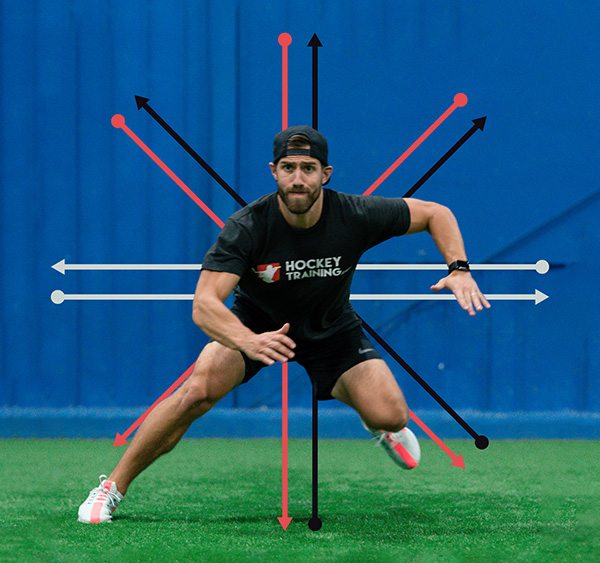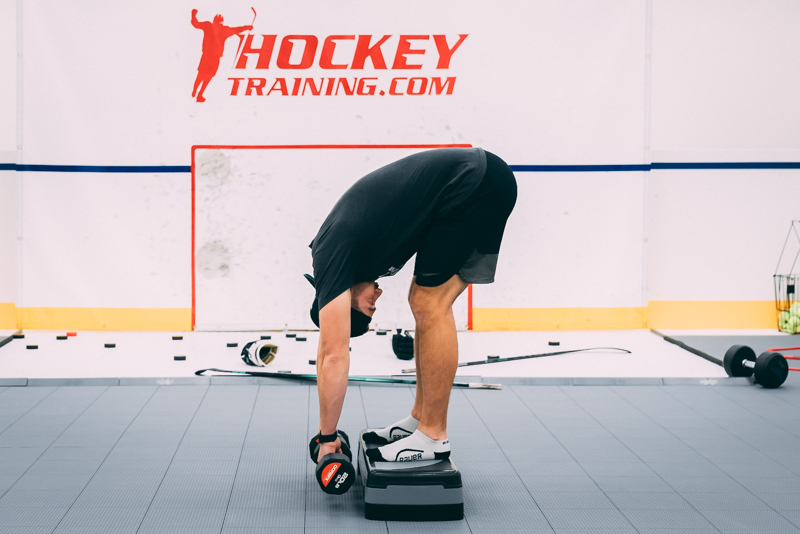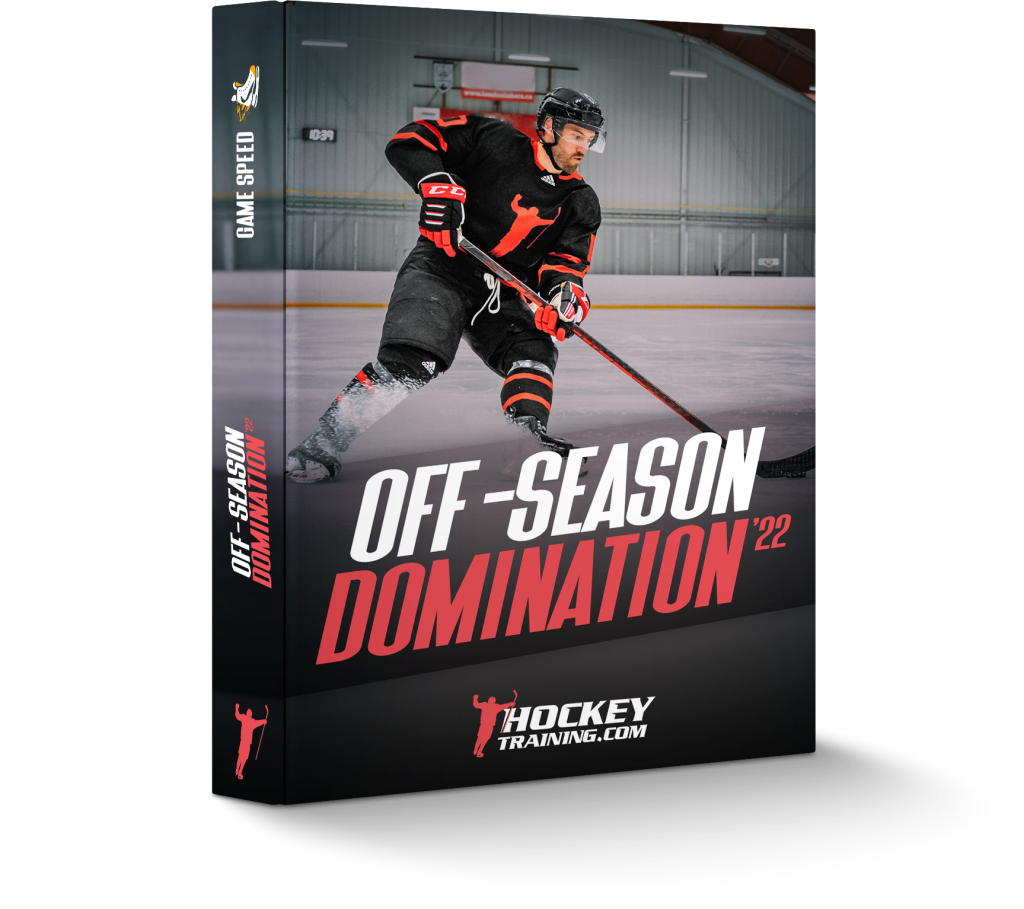In this article, I’m going to break down the science and application of loaded stretching, which hockey players can use to improve their all-around hockey performance, regardless of what their current focus is.
Sport-specific training is a term that has been misused by coaches who don’t understand sports science, making it difficult to define it in a way that hockey parents and players can understand.
Put simply, sport-specific training is about using the right tools at the right time to achieve a desired goal.
You don’t have to be balancing on a ball for something to be deemed “functional,” and you don’t need your exercises to look exactly like hockey in order to create a strong carryover from the gym to the ice.
A coach’s job is to constantly assess and reassess what interferes with optimal hockey performance and respond to that with the right protocols used within an analytical, systemized approach.
Becoming an expert in sports science rather than exercise equipment will always get the better result. The former has the knowledge to use any tool to gain the desired result, whereas the latter tries to make every player they come across fit into their convenient template.
By learning true movement optimization, you will be one step closer to reaching your hockey potential, and the industry will take one step closer toward leaving marketing gimmicks in the past.
Movement Optimization for Hockey

Movement optimization represents your ability to make every movement you make on the ice as efficient and effective as possible.
The problem is that the human body is extremely adaptive. It is genetically hardwired for survival and will adapt to every context of your life. This means we adapt to what we do the most, and we don’t adapt to what we do the least.
Movement is influenced by behavior, and behavior is influenced by both social and physiological factors.
For example, if you spend all day on your phone and on the computer, your body will adapt and become efficient in having a poor posture. This hurts your speed and injury resilience out on the ice—but your body doesn’t know or care about that, because it will adapt to what you do most.
School, work, social activities, hobbies, and hockey all influence the way in which our body will structurally adapt. Therefore, optimization is not about creating perfect movement, but rather utilizing hockey-specific protocols on a regular basis to reverse the adaptations of everyday life and optimize the adaptations that are going to serve you on the ice.
Movement optimization is your systematic strategy that takes into account the fundamentals of hockey-specific biomechanics with the goal of making you an all-around better hockey player, while simultaneously reducing your injury risk so your adaptations make your physiology “built for the sport.”
Reversing Poor Movement Patterns
Never underestimate your body’s ability to adapt to a stressor.
When something is creating stress to your body, whether that be psychological or physiological, our body’s many compensation mechanisms will immediately kick in to offset the context-specific stress so we can move forward with as little pain as possible.
While this is effective (the body is creating compensations to help you, not hurt you), it is not always efficient for hockey (these compensations may hinder your ability to maximize the context-specific movements of hockey).
This is known as “maladaptation.”
Maladaptation represents the scenario where your body gained an advantageous adaptation in one context but suffered maladaptations in another.
For example, having tight hips is something that will hold back your technical edgework as well as your stride frequency. However, if you sit down all day, which many people do, tight hips are a natural compensation the body makes to improve efficiency in that specific context.
Tight hips due to sitting: adaptation for sitting.
Tight hips due to sitting: maladaptation for skating.
An adaptation in one area of the body impacts movement patterns everywhere in life, but you will always adapt to what you spend the most time doing unless you have a selection of well-designed protocols to prevent the maladaptive processes from realizing themselves.
At the same time, we cannot only do exact hockey-specific movement patterns year-round either, as those movement patterns chronically performed without dryland general physical preparedness (GPP) movements balancing their structural adaptations lead to repetitive stress injuries.
The root of your thinking process should lie within the distinction between hypofunction and dysfunction. Hypofunction is when a muscle does not fire properly, leading to a dysfunction in another group that is supposed to be firing along with it.
For example, a hockey player with a weak core will often have tight hips because the body recognizes that the core is not strong enough to stabilize the pelvis, so it disallows the hips from going through a large range of motion as a protective mechanism.
In this scenario, hockey players blame their “tight hips” (dysfunction) and begin many hip mobility protocols, yet the root cause of the issue had nothing to do with the hips at all and instead was poor core stability (hypofunction).
Hypofunction almost always leads to dysfunction, but most hockey players and parents focus on the dysfunction because that’s the only thing they can subjectively feel.
There is a predictable cycle that leads to dysfunction, and it’s almost never the fault of the dysfunctional area itself, as the dysfunction represents a compensation pattern to offset the hypofunction of another muscle group.
Hockey players, parents, and coaches need to understand and reverse engineer their dysfunction to identify the areas where hypofunction is present.
When you can do this, you will be targeting your “weak link in the chain” and become an all-around better hockey player.
The Hockey Performance Solution: Loaded Stretching

Depending on who you ask, stretching is either one of their favorite things to do or it’s their least favorite thing to do.
However, there’s no doubt that neglecting it can lead to structural compensations down the road that limit your hockey potential. Furthermore, when you perform loaded stretching, you gain much more than just flexibility. You can expect:
- Improved dynamic mobility
- Increased muscle gain
- Increased strength
- Improved change of direction speed
- Greater recruitment of fast-twitch muscle fibers
- Enhanced mind muscle connection
- Improved stability through strengthening a muscle in its elongated state
- Strengthened and thickened tendons
Do I have your attention yet?
Loaded stretching is a beautiful marriage between eliminating hypofunction (due to strength development) and reversing dysfunction (through improving mobility in the target tissue) at the exact same time.
This is perfect for hockey players because your schedule is already busy enough with everything else on your plate. The more “bang for the buck” solutions you can accomplish, the better.
By the way, loaded stretching is not a new concept that I’m pretending to be innovative with. In fact, gymnasts have training logs from the ’60s that show this was a regular part of their weekly schedule.
Protocols in sports science only survive that many decades if they really work—not to mention, the science backs it up as well.
Although the biology behind the adaptations is complex, the concept is quite simple: put a muscle group in a stretched position while also contracting it hard at the same time.
Put simply, you are stretching a muscle while flexing it. This extreme contraction can increase muscle size and strength while reducing injury risk and maximizing functional hockey outputs.
One of my favorite parts about it is how rapidly it works. The athletes I prescribe this to consistently tell me that even though it’s very difficult, it is totally worth it because they are seeing and feeling the results in as little as two weeks.
Loaded Stretching: Benefits and Mechanisms
The benefits and mechanisms could be discussed within a 10,000+ word essay due to how many years loaded stretching has been around, how much research has been conducted, and how in-depth the metabolic pathways are.
To save time, I am going to give you the tip of the iceberg that you need to get started:
- Intracellular Muscle Strength + Growth Signaling: There is a “muscle building dial” you can activate in the body known as mTOR. I say “dial,” because if you turn it on a bit, protein synthesis pathways become active. But if you turn it all the way to the max, those pathways become stronger and build even more muscle and strength. Loaded stretching turns that dial way up because it maximizes eccentric contractions and places the muscle under load in a stretched position—both of which drive strength, growth, and stability in working structures.
- Maximize Agility Mechanics: In hockey, eccentric and isometric strength actions are critical for your agility potential, yet very few players emphasize these contraction types. If you are eccentrically weak, you lack the ability to decelerate (when stopping or changing direction quickly), which creates energy leaks and slow movement patterns. Additionally, if you are isometrically weak, you will have a delay between your absorption phase (stopping) and concentric phase (exploding in another direction), which kills the “stop–start speed” you need to have quick feet on the ice.
- Faster Fiber Recruitment for Explosive Speed: When you perform a properly designed loaded stretching protocol, you enhance your body’s ability to recruit more fast-twitch muscle fibers. When a muscle becomes hypoxic (low oxygen availability), it becomes reliant on fast-twitch muscle fibers, because those fibers do not require oxygen to the same degree as slow twitch fibers. Loaded stretching creates hypoxia, which forces early recruitment of fast-twitch fibers and holds the time under tension longer than they’re used to. Put simply, it becomes a way in which you can train the body to activate fast-twitch fibers quicker and keep them on longer than they would under any other circumstance, which will translate into more explosive power outputs.
- Improved Injury Resilience: Athletes most commonly get injured when a muscle is in its elongated state (think “pulling” or tearing your groin or hamstring) but is too weak to remain stable in that elongated state. Through loaded stretching while contracting that muscle, you are becoming stronger in the elongated state and also training the nervous system to become more efficient at muscular contraction when it is at its max length.
- Hockey-Specific Mobility: A mistake players make when it comes to hockey performance is that they think flexibility equals mobility. More importantly, active and dynamic mobility represent efficient contraction of muscle groups through their full range of motion in athletic movement patterns. So although flexibility helps improve range of motion, it’s not the only solution toward athletic mobility, as you need to be able to contract that muscle in an elongated state, remain stable during high-velocity movement, and ensure that you can move through a full range of motion. Luckily for us, loaded stretching accomplishes all three of these mobility components to both reduce injury risk and improve your skill technique.
Example Loaded Stretches for Hockey Players
Hip flexor dominant loaded stretch hold
Hip rotation dominant loaded stretch hold
Hamstring dominant loaded stretch hold
Chest & anterior shoulder dominant loaded stretch hold
Lat & shoulder extension dominant loaded stretch hold
Introducing: Movement Optimization Protocols
New this year, I’ve created specific loaded stretching routines designed for hockey players that I’ve named “Movement Optimization Protocols.”
These are routines that hockey players will follow two to three times per week throughout the entire off-season to get the desired hockey benefits talked about above (intracellular muscle strength and growth signaling, faster fiber recruitment, maximized agility mechanics, etc.)
The Movement Optimization Protocols are found in our brand-new Off-Season Domination ‘22 System that we’ve just recently launched to the public.
If you are serious about improving your hockey performance, then you have to extract every last ounce of performance optimization from your off-season, because right now is the time where you can create massive progress.
Stop thinking you need to be genetically gifted to make serious leaps in your hockey performance. This is a self-limiting belief where you are your own worst enemy, because you are the only one getting in the way of reaching your potential.
If you want access to an NHL-caliber off-season program, check out the Off-Season Domination ‘22 program today.
Of course, you could use the above example loaded stretches and slowly piece together all of your functional strength, speed, conditioning, and agility work through the various other articles on this site. And you know what, you’d probably do “fine,” but not great.
If you want to take the guesswork out of it and get access to a completely “done for you” cutting edge off-season program to completely transform your game, then invest in your performance with the new Off-Season Domination ‘22 system, and let’s blast through those plateaus that have been holding you back.
I’ve worked with thousands of hockey players for over a decade; take advantage of that experience so you can get twice as far in less than half the time.
The Off-Season ‘22 system includes a full gym, home gym, and bodyweight-only version, so no matter what your schedule looks like this off-season, you will always have a go-to performance booster to ensure you get better each and every week.
If you want to shock the coaches this year with your speed, edge work, shot power, and all-around improved game, join the team here, and let’s get to work.


